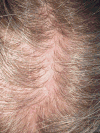Cold thermal injury from cold caps used for the prevention of chemotherapy-induced alopecia
- PMID: 27146710
- PMCID: PMC5612426
- DOI: 10.1007/s10549-016-3799-7
Cold thermal injury from cold caps used for the prevention of chemotherapy-induced alopecia
Abstract
Introduction: The use of scalp cooling for the prevention of chemotherapy-induced alopecia (CIA) is increasing. Cold caps are placed onto the hair-bearing areas of the scalp for varying time periods before, during, and after cytotoxic chemotherapy. Although not yet reported, improper application procedures could result in adverse events (AEs). At present, there are no evidence-based scalp cooling protocols, and there is no regulatory oversight of their use.
Objective: To report the occurrence of cold thermal injury (frostbite) on the scalp, following the use of cold caps for the prevention of CIA.
Materials and methods: We identified four patients who developed cold thermal injuries on the scalp following the application of cold caps. Medical records were analyzed to retrieve the demographic and clinical characteristics.
Results: The cold thermal injuries in our patients were grade 1/2 in severity and improved with topical interventions and interruption of cold cap use, although grade 1 persistent alopecia ensued in 3 patients. The true incidence of such injuries in this setting, however, remains unknown.
Conclusions: Cold thermal injuries are likely infrequent and preventable AEs that may result from improper device application procedures during cold cap use. Although these untoward events are usually mild to moderate in severity, the potential occurrence of long-term sequelae (e.g., permanent alopecia and scarring) or the need to discontinue cold cap use, are not known. Prospective studies are needed to further elucidate the risk and standardize healthcare delivery methods, and to improve patient/supportive/healthcare provider education.
Keywords: Chemotherapy-induced alopecia; Cold caps; Cryotherapy; Frostbite; Scalp hypothermia; Thermal injury.
Conflict of interest statement
The other authors declare that they have no conflicts of interest.
Figures




Similar articles
-
Efficacy of Scalp Cooling in Preventing Chemotherapy-Induced Alopecia in Breast Cancer Patients Receiving Adjuvant Docetaxel and Cyclophosphamide Chemotherapy.Clin Breast Cancer. 2015 Oct;15(5):332-4. doi: 10.1016/j.clbc.2015.01.003. Epub 2015 Jan 26. Clin Breast Cancer. 2015. PMID: 25749072
-
Effect of a Scalp Cooling Device on Alopecia in Women Undergoing Chemotherapy for Breast Cancer: The SCALP Randomized Clinical Trial.JAMA. 2017 Feb 14;317(6):596-605. doi: 10.1001/jama.2016.20939. JAMA. 2017. PMID: 28196254 Clinical Trial.
-
Association Between Use of a Scalp Cooling Device and Alopecia After Chemotherapy for Breast Cancer.JAMA. 2017 Feb 14;317(6):606-614. doi: 10.1001/jama.2016.21038. JAMA. 2017. PMID: 28196257 Free PMC article.
-
Evaluation of Prevention Interventions for Taxane-Induced Dermatologic Adverse Events: A Systematic Review.JAMA Dermatol. 2018 Dec 1;154(12):1465-1472. doi: 10.1001/jamadermatol.2018.3465. JAMA Dermatol. 2018. PMID: 30383138
-
A Clinical and Biological Guide for Understanding Chemotherapy-Induced Alopecia and Its Prevention.Oncologist. 2018 Jan;23(1):84-96. doi: 10.1634/theoncologist.2017-0263. Epub 2017 Sep 26. Oncologist. 2018. PMID: 28951499 Free PMC article. Review.
Cited by
-
Barriers and enablers to implementing scalp cooling in Australia: a qualitative study of health professionals' attitudes to and experience with scalp cooling.Support Care Cancer. 2018 Jan;26(1):305-312. doi: 10.1007/s00520-017-3849-7. Epub 2017 Aug 29. Support Care Cancer. 2018. PMID: 28852873
-
Hair disorders in patients with cancer.J Am Acad Dermatol. 2019 May;80(5):1179-1196. doi: 10.1016/j.jaad.2018.03.055. Epub 2018 Apr 14. J Am Acad Dermatol. 2019. PMID: 29660422 Free PMC article. Review.
-
Reduction in oral mucositis severity using a topical vasoconstrictor: A case report of three bone marrow transplant patients.Integr Cancer Sci Ther. 2018 Dec;5(6):10.15761/ICST.1000293. doi: 10.15761/ICST.1000293. Epub 2018 Nov 29. Integr Cancer Sci Ther. 2018. PMID: 31832233 Free PMC article.
-
Scalp hypothermia as a preventative measure for chemotherapy-induced alopecia: a review of controlled clinical trials.J Eur Acad Dermatol Venereol. 2018 May;32(5):720-734. doi: 10.1111/jdv.14612. Epub 2017 Nov 24. J Eur Acad Dermatol Venereol. 2018. PMID: 28976026 Free PMC article. Review.
-
Low temperature upregulating HSP70 expression to mitigate the paclitaxel-induced damages in NHEK cell.PeerJ. 2023 Jan 17;11:e14630. doi: 10.7717/peerj.14630. eCollection 2023. PeerJ. 2023. PMID: 36684674 Free PMC article.
References
-
- Stevens DM, D’Angelo JV. Frostbite due due to improper use of frozen gel pack. N Engl J Med. 1978;299:1415. - PubMed
-
- Quist LH, Peltier G, Lundquist KJ. Frostbite of the eyelids following inappropriate application of ice compresses. Arch Ophthalmol. 1996;114:226. - PubMed
-
- Sohatee MA, Brierley NA, Muir T. “Salt ice dare”: a previously un-described mechanism of rapid frostbite injury. J Plast Reconstr Aesthet Surg. 2014;67:e248–9. - PubMed
-
- Brown WC, Hahn DB. Frostbite of the feet after cryotherapy: a report of two cases. J Foot Ankle Surg. 2009;48:577–80. - PubMed
Publication types
MeSH terms
Substances
Grants and funding
LinkOut - more resources
Full Text Sources
Other Literature Sources
Medical
Miscellaneous

